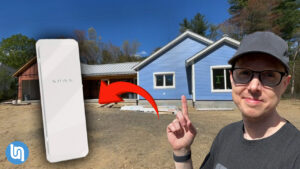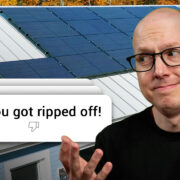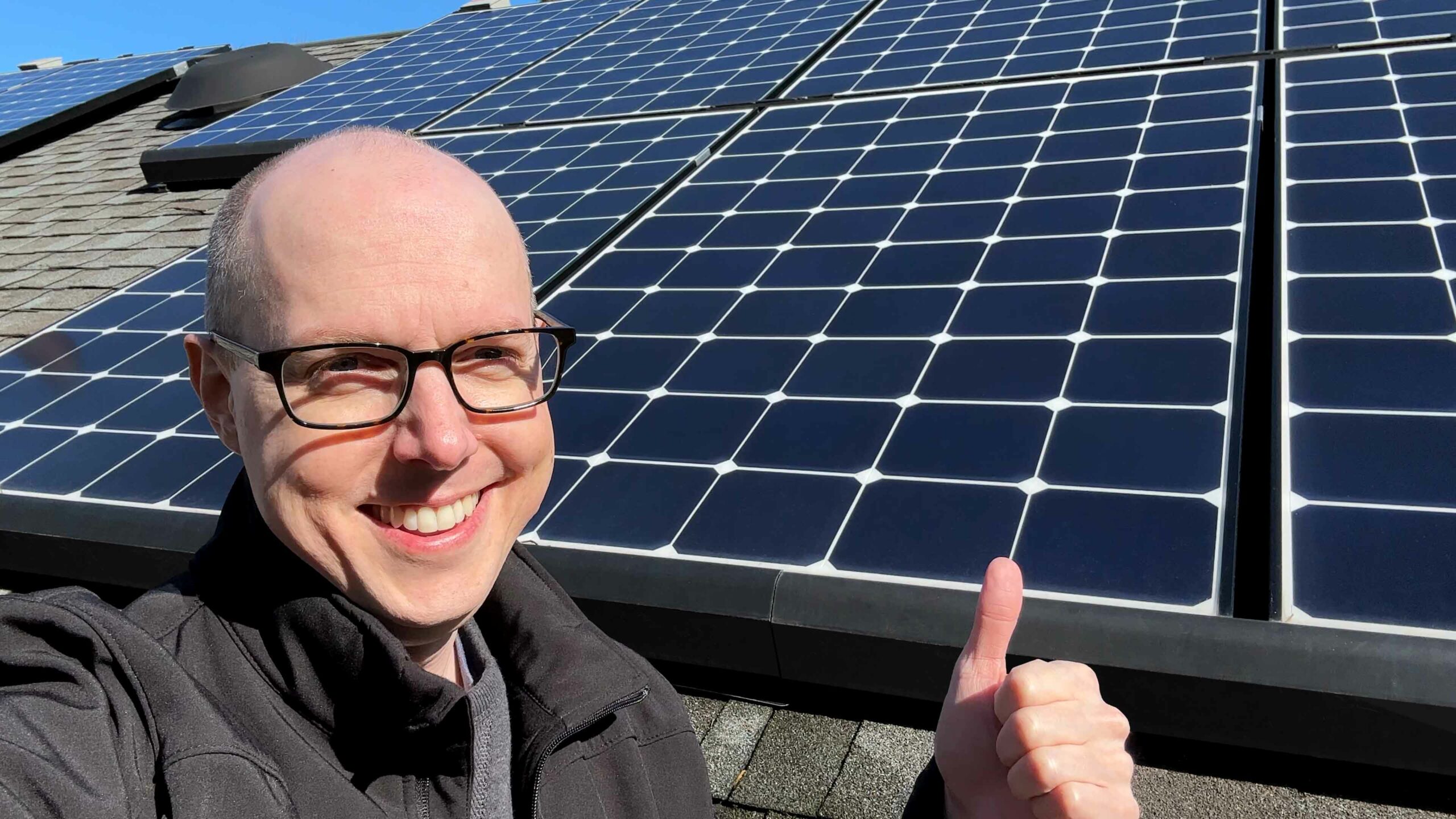There’s a lot of people that want to go solar, but just can’t because of cost or they don’t own a home where they can install it. What if there was a way for you to get the benefits of solar, but without needing to install solar on your roof?
Solar power has so much potential to solve our energy needs. The amount of power that hits the earth in a single hour from the sun is enough to power the world’s energy needs for an entire year.1 We just have to build out ways to capture and store it. And that’s not the only challenge.
I hear from so many people that they want to go solar, but they rent an apartment. Or that they can’t afford the upfront costs to install it on their home. Or that they just can’t see the investment making financial sense given how cheap their electricity already is compared to their use.
According to the National Renewable Energy Laboratory here in the US, about 35% of residents are renters. They also estimated that only about 51% of residential buildings can accommodate a PV system of 1.5kW or larger due to ownership, number of stories, suitable roof space, and shading.2 And if you live in a home owners association they often have requirements around where and how large of a system you can install on your home, so that it won’t affect the look of the neighborhood. In some states HOAs aren’t allowed to ban them, but they can drastically reduce their effectiveness.3 All of that leaves a pretty sizable group of people in the United States that can’t do solar even if they wanted to. It’s a similar situation in Europe. Home ownership ranges by country, but among the EU member states it averages out to about 70% owning versus renting.4 5
I’ve been wanting to make a video about this issue for a while, and there’s been some recent developments that tipped me over the top. There’s a really interesting path for people in this situation that’s been gaining steam: community solar. Sometimes they’re called solar gardens, which is playing off of community gardens. The basic concept is kind of stupidly simple. A community comes together to invest in and build out a small solar farm on a plot of land. Each person of that community can buy in, or pay a subscription to that community solar project, and then they get money or credits back towards their electric bill. The bottom line is that you’ll be reducing your electricity bill without having to install solar on your own property or home.
As I mentioned, there are two basic models for community solar: 1) Ownership, and 2) Subscription. In the ownership model you’re buying a share in the project and will get a percentage of the power produced based on how many shares you own. It’s probably not the best analogy, but it’s kind of like a timeshare. You can’t afford owning a vacation home in Hawaii, so you pool your resources with other people and share that vacation home at different times of the year. It’s a different sharing principle … so … yeah, not the best analogy.
Anyway, in the ownership model you can purchase a certain number of panels in the farm up front, or get financing for it just as if you were installing them on your own home. You’re buying a certain number of panels and kWs within the larger system. And just like installing on your own home, you’d buy a number of kWs that’s sized appropriately for your average energy use.
The second model is subscription based, which doesn’t offer as much of a return on investment, but most don’t have upfront costs or sign up fees. You can jump in and start getting savings right away, and then back out if you move or aren’t happy with it. You typically have to live withing a certain zone of the solar farm to sign up and you’ll see a monthly savings in your energy bill between 5-15%.
The first hurdle towards either of these options though is something called virtual net metering, and not every community may have this available. I live in Massachusetts, which has both net metering and virtual net metering available. For the solar panels that I have installed on my roof, I get a 1 to 1 exchange for each kW of overproduction I put into the grid versus what I take out. So if I put $1 worth of electricity into the grid, I get $1 taken off my electricity bill. Virtual net metering does that same thing, but without having to have the panels installed on the building that’s getting the benefit. Virtual net metering unlocks the potential for community solar projects like these.
If you look across the US, the top contender for community solar isn’t California as you might expect, it’s Minnesota. As of 2017, Minnesota had over 1,000 community solar proposals awaiting approval.6 In the second quarter of 2020, the top contender is still Minnesota’s community solar program with over 700MW of capacity. Massachusetts is another one of the top states for community solar and is at about 300MW of capacity.7
Where they’re installed is kind of fascinating. In some cases community solar projects lease land from someone like a farm owner. For example, there’s the Eichten’s Hidden Acres 5MW solar farm, which is made up of over 15,000 panels in Center City, MN. Eichten Acres is a family owned cheese and buffalo ranch that leases out a portion of their land for the project. All in, this facility is powering 650 homes a year, but could handle up to 1,300 energy efficient homes.8 9 As the owner of the ranch said:
"It’s a good use of my land to help society."
But where you’re able to jump into these projects is really hit or miss. In the US there are only 19 states that have legislation supporting community solar projects and virtual net metering. This image from Solstice also shows the states that have at least one independent project online, but don’t have official laws supporting them.10
If you journey out of the US it gets a bit murkier from what I was able to find. Europe doesn’t have many community solar projects at the moment because of a lack of consistent regulatory frameworks,11 but that may be about to change. The 2030 EU Renewable Energy Directive is laying the groundwork for those missing frameworks. All 28 member states have to design laws that will ease the way for community energy generation and consumption.12 Volker Quaschning, a professor of renewable energy systems at the University of Applied Sciences in Berlin has said:
"Citizen energy is the key to getting the acceptance necessary to make the energy transition happen." -Volker Quaschning, University of Applied Sciences, Berlin
In the UK, the mayor of London launched a second round of funding for community energy projects, which is part of his goal to hit 1GW of installed solar capacity by 2030.13 And just this year France removed a footnote from their energy code that was holding back community energy systems.14
And in the land of residential Solar, Australia, it shouldn’t be a surprise that they have a lot of community solar options available. There’s a lot of investment options into community solar projects, as well as community solar programs that you can sign up for as a customer.15
One of the biggest challenges is finding a project or a place to start … and then knowing what to look for. So, can you find a community solar project near you? Well, for anyone in the US, a great resource is Energysage, which I’m actually a partner of. I’ve been a big advocate of using Energysage if you’re looking for a solar installer, but they also have rolled out a community solar portal. I’ll include a link to my Energysage portal below, but it’s as easy as entering your zip code and average monthly energy bill. From there you can see what type of savings you can expect, and what the high level contract terms are for each project.
If you’re outside of the US, I’ll include some links I found for other programs and companies that can help with your search. A few quick ones are Solarsense in the UK, Enova Community Energy in Australia. Community Solar Portal and Farming The Sun which are worth checking out there too. If you know of any good programs or portals, please drop me a comment and I’ll add them to the list.
The other challenge is know what to look for in a project, whether you want to own or do a subscription. If you’re looking towards an ownership model, pay attention to the total size or kW of the share that your interested in. And just like installing solar on your home, what’s the per watt price? It’s the best way to compare projects in an apples to apples way. Are there any production guarantees or expected production estimates? Compare the cost of the system to how much you’ll be saving to estimate a payback period and if it aligns with your goals. And finally, be sure that the final offer and price includes all equipment and administration costs. You don’t want any fees sneaking up on you. If you end up moving, you can usually continue to receive the virtual net meter credits associated with your share, but you can also exit by selling the panels to someone else.
Subscription programs are much simpler, both cost-wise and for the things to look out for. What are the membership and sign-up fees that will affect your overall savings? And are there early termination fees if you want to leave? Many of the programs I’ve seen in my area don’t have early termination fees or they just require 90 days notice, but make sure you understand both of those points before jumping in. Beyond that there are different styles of subscription systems like:
- Utility rate discount
- Some of the ones I’ve looked into say a 10% price discount vs. what you pay now. So it fluctuates along with current electricity prices.
- Escalating solar rate
- This usually means you start at a fixed lower rate and then slowly increase that rate by a certain percentage each year after that.
- Flat per-kWh rate
- Sometimes they’ll price a kWh rate slightly higher than what you’re currently paying for electricity, but it won’t go up at all over time. So with the expectation that electricity prices will increase in time, you’d save money down the road.
- Fixed monthly fee
- This is similar to the flat per-kWh rate since you’ll be getting a certain number of credits towards your bill each month. Over time those credits become more valuable as electricity rates increase.
- Lease to own
- After a certain number of years, your payments stop and the solar credits you receive each month are free.
- Partial and full up-front payments
- Probably what you expect, but pay a lump sum to get deeper discounted rates.
Community solar isn’t going to bring solar to every corner of the globe… yet. But it’s a step in the right direction and can open up the possibility of going solar for a much larger population.
- Business Insider-This incredible fact should get you psyched about solar power ↩︎
NREL-Shared Solar: Current Landscape, Market Potential, and the Impact of Federal Securities Regulation ↩︎
Solar Power World-Solar does work within HOAs, but installers have to stay vigilant ↩︎
Statista-Home ownership rate in selected European countries in 2018 and 2019 ↩︎
Energysage-Top Community Solar States: Minnesota vs California, Massachusetts Colorado Community Solar ↩︎
Solstice-Here Are the Top 19 Community Solar States in 2019 ↩︎
Energy Transition-The Triumphant Return of Community Energy ↩︎
Solar Power Portal-Sadiq Khan launches second phase of community energy funding as solar push continues ↩︎















Comments